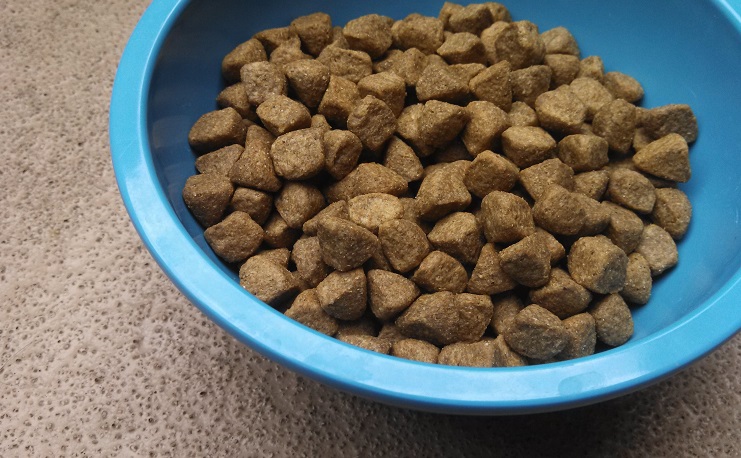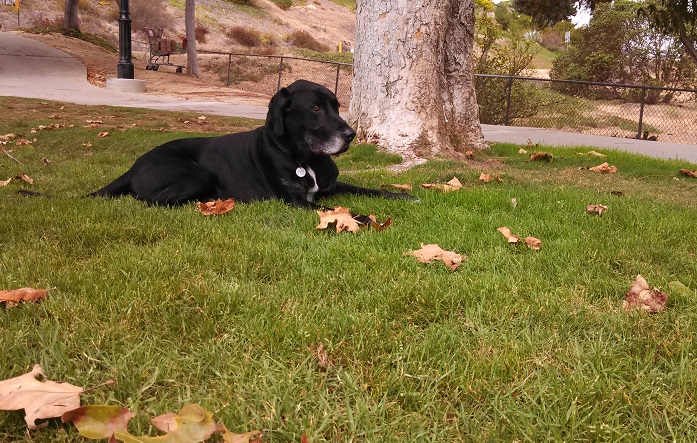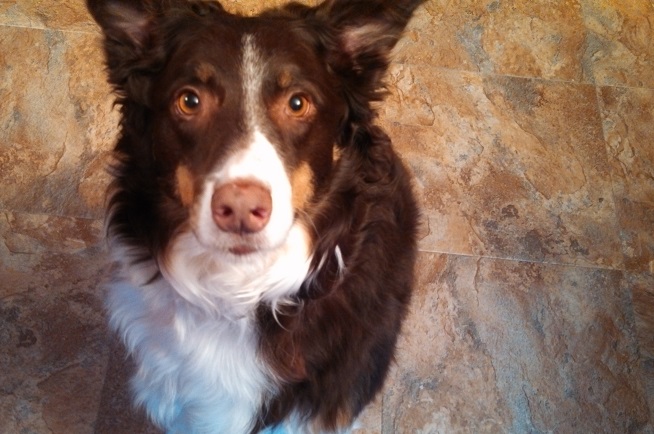What does ‘natural’ mean on dog food labels?
In this post:
- What is the definition of “natural” and other terms for our own food labels?
- Do these definitions change when we’re referring to pet food?
- What should dog owners do to make sure the pet food they’re buying is high quality?
What is the definition of ‘natural’ for human-grade food labels?
I think it helps to have some idea of what certain terms mean for our own food labels. Obviously, if you’re feeding your dog a raw diet with store-bought meat, these labels affect your dog, too.
I’ve chosen several phrases and looked at what they mean for our own food as well as what they mean for commercial pet food – raw dog food, dry or canned. I’d also love to hear your thoughts on how you determine if a pet food is high quality.
“Natural” or “all natural”
In our food:
This label doesn’t mean much.
“Natural” has nothing to do with how the animals were raised, but it’s about how the meat is handled after slaughter, according to David Maren. Maren is the general manager of Tendergrass Farms, a group dedicated to sustaining grass-fed family farmers. He wrote a blog post on what you should know about beef production claims.
The USDA defines “natural” as a food product that has been minimally processed and contains no chemical preservatives or artificial ingredients, according to Molly Watson, a guide for About.com’s “Local Foods.” [1] Under that definition, pretty much any meat would pass as “all natural” as long as it’s not artificially flavored or preserved.
Note that under this definition, “natural” meat can come from animals that were given growth hormones and subtherapeutic antibiotics.
In pet food:
The AAFCO has developed a “feed term definition” for which ingredients can be considered “natural” in pet foods, according to the FDA’s web site [2]. Using that definition, “natural” means the product does not include artificial flavors, artificial colors or artificial preservatives.
While the word “natural” can indicate the food is free of artificial ingredients, it’s more of a marketing tool than an indication of a food’s quality, according to Steve Pelletier, CEO of Slimdoggy.com, a web site that provides info and tools on how to properly feed and exercise dogs.
“Raised without added hormones”
In our food:
The phrase is significant for beef and lamb, but meaningless in chicken and pork.
“Nearly all beef in the U.S. is raised with both artificial hormones and subtherapeutic antibiotics,” according to Maren. Feedlot cattle are usually implanted with a pellet containing either estrogen or androgen hormones to maximize their growth. Artificial hormones and subtherapeutic antibiotics are also legal in U.S. lamb production.
However, he wrote that federal regulations have never permitted the use of hormones or steroids in poultry.
Claiming your chicken was raised without added hormones is “comparable to someone claiming that their bottled water is ‘fat free,'” he wrote.
The “raised without added hormones” label is also meaningless in pork, Maren wrote. This is because artificial hormones are not allowed in pigs, but most pigs are instead given a chemical feed additive called Paylean to artificially promote leanness.
I keep all of this in mind when I’m buying meat for myself as well as when I’m buying ingredients for Ace’s homemade raw dog food.
In pet food:
There are no agencies that regulate a pet food company’s claims to use protein from animals raised “without added hormones,” according to Brad Kriser, CEO of the pet retailer, Kriser’s. “So we just have to trust.”
He said the FDA monitors the food’s safety, “but it does not provide a seal that supports these claims.”
These types of labels would of course be meaningless anyway if the protein source is U.S. chicken or pork, based off the information from Maren.
“Antibiotic free”
In our food:
This phrase has significance because the majority of beef, pork and poultry raised in this country is fed subtherapeutic antibiotics, according to Maren.
For example, instead of being used after a specific veterinary diagnosis, these antibiotics are “added to a cow’s daily ration to maximize its ‘performance’ when packed into feedlots with tens of thousands of other potentially sick cows,” he wrote.
In pet food:
Some pet food companies claim they use protein sources that were raised without antibiotics, and all we can do is trust those claims. Assuming they are being honest, this has significance since the majority of animal protein that ends up on our own plates (let alone in pet foods) comes from animals that were regularly fed antibiotics.
“Organic”
In our food:
This label carries a lot of significance.
Organically produced ingredients can’t be produced with any antibiotics, added hormones, pesticides, petroleum or sewage-based fertilizers, bioengineering or ionizing radiation, according to the GreenCityBlueLake Institute [3].
“To claim a product is ‘100% organic,’ it must contain 100 percent organically produced ingredients, not counting added water and salt,” according to Pelletier. Companies can claim a product is “organic” if it contains at least 95 percent organic ingredients, not including added water or salt. In that case, the company must identify the organic ingredients as “organic” in the ingredient list.
“Only products that fall into these two groups may use the ‘USDA Organic’ seal,” he said. However, companies can claim a product is “made with organic ingredients” or “made with some organic ingredients.” They just wouldn’t be able to use the seal.
In pet food:
According to the FDA’s web site, “There are no official rules governing the labeling of organic foods for pets at this time.” [2]
Dog food company Hill’s Science Diet says on its web site that “Pet food companies can currently use the term ‘organic’ if they follow the same rules as applied to human foods.” However, “final rules have not yet been made.” [4]
I think we’re headed in the right direction but it’s still a little wishy-washy. I like seeing “made with organic ingredients” on pet food labels, and I trust that these companies are indeed following the same standards for “organic” that we expect from our own food.
If buying organic food for your dog is important to you, Pelletier recommends you look for the USDA seal on the pet food.
“Pet foods with that seal must contain 95% to 100% organic ingredients,” he said.
Labels like “holistic” and “premium” are meaningless on pet food labels. There’s nothing necessarily bad about these labels, but they can be misleading.
“Holistic” or “premium” pet foods are not required to contain any different or higher-quality ingredients than any other complete and balanced pet foods, according to the FDA’s web site [2].
These types of words “can be used as the brand desires for marketing purposes,” according to Pelletier.
Kriser also said, “Any company can use these terms.”
So what should dog owners do with this information?
1. Look beyond marketing terms such as “natural,” “premium” and “holistic.”
You don’t have to avoid pet foods that use these terms, but make sure to look beyond their marketing tricks if buying a certain type of food is important to you. You would hope companies that use terms such as “natural” or “holistic” are actually putting out a higher-quality product, but that’s not always the case.
2. Read the ingredients on the pet food label.
Pelletier believes dogs are omnivores, but since they are descendants of wolves they should be fed food that includes:
- meat as the first ingredient
- real, named protein sources like beef or chicken
- no by-products.
- high-quality fats
- high-quality carbs like oats or peas
- no artificial ingredients (for example “red 40” or Propylene Glycol)
- little or no fillers – be wary of foods that list corn as one of the first few ingredients
“Real animal proteins, whole grains and fiber should be the key ingredients,” said Dr. Preston Buff, the chief natural nutrition officer at The Nutro Company, a manufacturer of pet food products. This means “they should be the first few ingredients listed.”
3. When in doubt, contact the company and ask questions.
Possible questions to ask could include:
- Which ingredients in your product are organic?
- Does the animal protein come from animals raised in the United States? If not, why?
- Where are your chickens raised? And how are they raised?
- Where does your company obtain its fruits/veggies/oats, etc.?
Great companies putting out high-quality products should be happy to answer your specific questions or concerns.
How about the rest of you? How do you determine if a pet food is high quality?
Citations
1. About.com: http://localfoods.about.com/od/meatpoultry/tp/meatlabels.htm
2. FDA’s web site under “Other claims” http://www.fda.gov/animalveterinary/resourcesforyou/ucm047113.htm
3. GCBL is a sustainability center of The Cleveland Museum of Natural History. “What do food labels really mean?” http://www.gcbl.org/live/food/healthy-diet/what-do-food-labels-really-mean
4. Under “What is meant by a ‘natural, organic, holistic or human grade’ pet food?” http://www.hillspet.com/faq-ingredients-and-myths.html




Terri
Thursday 10th of October 2013
Hi Lindsay, I feed my dogs Nature's Variety Instinct Raw Bites. It's very expensive, but my dogs are small, so it lasts a couple of weeks. It's a frozen raw food that has fruits and vegetables as well as meat, organs and bones. It is also gluten and grain free. It is all natural, as I can read all the ingredients and know what they are. I really love this food because I inherited a Shih Tsu from my mother. I've written to you about her before. Her eyes leak and makes her face smell so bad that I have to wash it daily. I looked up online what to do and tried several additives to her Science Diet food. All to no avail. A couple of people recommended a grain free diet. So, I switched to this food with no tear additives. Her eyes still leak, but the awful smell is completely gone! I may try the additive again to see if I can stop the tear stains completely, but the smell was my real problem. No one wanted to hold the poor baby because her face smelled so bad unless I washed it daily. And dog wipes did nothing. It was an all out facial wash with baby shampoo that would get rid of the staining and smell. It took a couple of months of using this food for the smell to completely leave. But I noticed a decrease within the first couple of weeks. I use this food for my Jack Russell also, because I think if I can actually see such great results on the outside, what's happening on their insides. I'm thinking good stuff!!
Lindsay Stordahl
Thursday 10th of October 2013
Wow, that's very interesting. I've looked into Nature's Variety Instinct raw as well. It's just a little bit expensive for my 70-pounder :) So glad to hear you've found a food that works for your dogs, and something that takes away the odor!
Pipa
Tuesday 1st of October 2013
I was about to suggest that kangaroo meat is a fantastic, cheap and natural meat to raw feed your dog...then I remembered that you guys are in the U.S haha. Probably not as cheap for you as it is for me!
Lindsay Stordahl
Tuesday 1st of October 2013
I've never even seen kangaroo meat anywhere in the U.S. I'm sure it's somewhere, but not cheap! :)
Aisling
Monday 30th of September 2013
Hi Lindsay, I try give my dog the healthest food I can but the genuinely organic ones are so expensive....so it doesnt always work out that way. I could spend hours in the dog food aisle looking for the best food as I go through all of the ingredients. Food like Pedigree Chum which you would assume would be one of the best as it is so well known, but it has two compenents of corn (the first item in the list being corn) and also it doesnt have one ingredient of proper meat....its all meat meal!
The ingredients are listed in order of amount you will find in the food. So whatever is first in the list, it has the highest percentage of in that food. As I said before, I do my best to look for the best food for my dog but sometimes the less quality foods are more affordable.
Lindsay Stordahl
Monday 30th of September 2013
Yes, I always recommend people buy the highest-quality of food that they can afford. For example, I don't buy organic food most of the time for myself or my dog. I would love to, but for the most part it's just too expensive.
Kimberly Gauthier
Saturday 28th of September 2013
I start with where the food is in the pet store - that says a lot, because our pet stores (the ones in my town) have a pattern and they organize by quality. From there, I read the ingredients. I don't get them all, but I'm interested in the first 5 ingredients and now I'm interested in the source of vitamins - there are so many things that are included in the ingredients, but the source is the cheapest option available, making it less quality for our dogs.
And I consider what our dogs need. The reason we don't feel kibble is because (1) two of our dogs have arthritis and kibble based diets aren't great for joint pain. (2) Sydney tends to pack on the weight so she truly needs grain free, but she doesn't like that (my girl likes her carbs). And (3) the grains and yeast (vitamin b) in kibble resulted in rashes and ear infections in our dogs.
Elizabeth
Friday 27th of September 2013
Thanks for the article!!! We use Canine Cavier and the interesting thing that I have just found out is both of my mutts urine have a high pH. Not sure yet what that means but going to find out!!!
I've been on a kick with equine nutrition and by reading your blog I feel like I've been neglecting the pups nutritional needs!!! Not that they aren't spoiled or loved, but hey, it could always be better! I was actually at a local pet store and they have Nature's Variety in a freezer and $70 for large bag of patties, that I don't think would last the month, puts me off for that kind of stuff. But I will continue and soldier on with learning. Always good to learn and do research, and don't be scared by it.
Thanks for all your help in doing the beginning research for all of us!
Elizabeth
Monday 7th of October 2013
Lindsey I know you have a post regarding vets and dog nutrition. I must tell you I am horrendously fustrated by the vets in Anchorage. Our 13 year old poodle, MAX, has heart failure, and the diet prescribed was Science Diet H/D or K/D. Well last week, Max decided he didn't like it and wasn't going to eat it. So I did some research off this post. Decided I wanted to try Sojo's Fruit and Veggie mix and also wanted to consult my vet. Friday I took him in and we figured out that Max has Right Ventrical heart Failure. She upped his lasix, he is now getting more lasix than his 200 lb dad, and gave him an appitite stimulant. I brought some printed information about Sojos and she was kind of flippent, you can try it but he really needs to be on the H/D. Its the best thing for him.
I went and got the Sojo's Fruit and Veggies and you know what, Max doesn't have an appitite problem, he has a Science Diet issue. He's gobbling the Sojo's with his turkey and chicken meat.
I talked to another vet at the barn yesterday and his response was pretty much the same, Science Diet has done the research and they know what they are doing.
I was soo fustrated!!! I messaged a local photographer who is big on volunteering and the dog community in Anchorage and I found out there really isn't a vet in Anchorage who will go against Science Diet. Totally FUSTRATING!!!
Reading ingredients last night and I have to say that the Sojo's, which is freeze dried, has a smaller list of ingredients, which I knew all of them except one! And that one was EASY to look up on their website! Reading the Science Diet, I got halfway down and stopped because I had NO CLUE what they were adding to this food to even make it sound good.
So Max will get Sojo's and hopefully his heart and liver will reduce in size and he will be around for a couple more years. Praying at least!
His dad has told me that the last two days, since starting Sojo's, he's been back to his old self, and not whining at night. Even thinking about switching my dogs to it. Its a whole lot nicer when you can read and understand everything that is on the label! :-) Thanks for letting me rant!